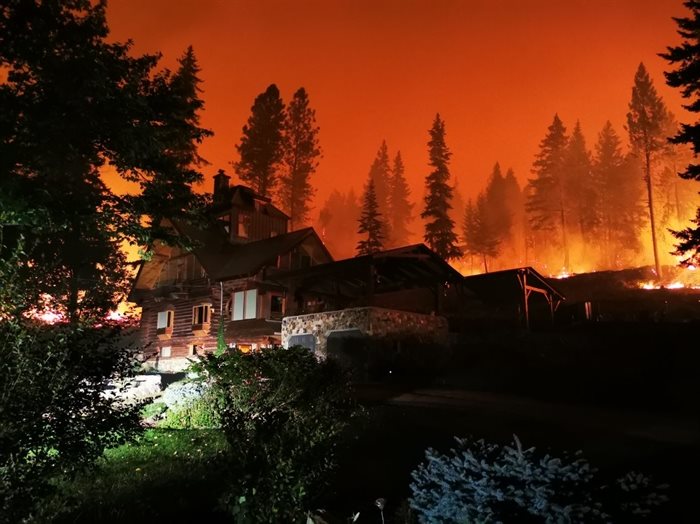Conflict between locals and wildfire authorities heating up in North Shuswap

A conflict has developed in the North Shuswap between some residents who stayed behind to protect homes and properties from the Bush Creek East wildfire and local authorities requesting they leave the area.
Suspected to be caused by lightning strikes, the Bush Creek East wildfire was first discovered burning in the Adams Lake area on July 12 and since then has grown to over 40,000 ha in size after burning through several communities destroying structures and causing the closure of a stretch of the Trans-Canada Highway between Chase and Sorrento.
Several locals stayed behind to protect their homes and properties, something the regional district and other authorities did not express approval of in several media releases on the CSRD website.
The district issued a public and first responder safety message Aug. 21 stressing that when residents remain in evacuated areas it puts residents and responders at high risk.
“Interfering with BC Wildfire crews not only endangers your safety but also hinders their vital work,” the release reads. “Please be aware that if their operations are disrupted, they may have no choice but to relocate to a safer area.”
The sentiment was echoed on a district video release by director for Emergency Operations Centre, Derek Sutherland, on Aug. 22.
“We have had issues with people that are choosing to stay and defend in the area. We would ask that all people please evacuate when there is an evacuation order is in place,” he said. “The people who choose to stay and defend need to stay on their property, if they’re off their property they are interfering with BC Wildfire operations.”
North Shuswap resident Jim Cooperman said there are still thousands of hot spots burning and the locals are the reason more structures have not burned down.
“Many are loggers and contractors with equipment and water tanks are working day and night putting out spot fires," he said. "There are firetrucks from around the province here doing a great job but they leave at night. Locals sleep during the day and stay up at night to keep working. We lost several homes to spot fires and if it wasn’t for these local people many more homes would have burned down.”
In recent media including those published on the CSRD website there have been claims by authorities that firefighting equipment set up in the area has been stolen.
“We have had incidences of pumps, sprinklers, hoses and side-by-sides stolen in the area to support their own efforts,” said director Sutherland in the Aug. 22 video release. “So we would ask that this please stop and that people do evacuate when we ask them to.”
Cooperman denied that accusation only referring to one occasion where a fire department didn’t realize the situation, took some equipment and brought it back. He said the equipment is too heavy and difficult to pick up. He said the accusation was made to help “maintain the need for a police presence.”
“The district and province label (those who stayed behind) as disobeying orders so now we have a monster police presence here with police from Vancouver,” he said. “They have blockades and spike belts and are blocking the delivery of supplies. People have the right to stay in their homes but cannot go in and out and are running out of supplies. Now they have police on the lake chasing down boats and blocking people, police with binoculars are watching.”
Today, August 23, the CSRD released a video update from deputy regional fire chief Sean Coubrough. He thanked the community for coming together to help battle the fire when it blew up on Aug. 18, but now he’s asking the community to stop interfering with trained personnel trying to do their jobs. He said there is a small percentage of the community that has been negative towards firefighting efforts.
“We’ve had some instances of threats, abuse, theft of equipment, and other unfortunate events,” Coubrough said. “For that reason it makes it very difficult for us to do our job. These men and women who’ve been working so hard, they certainly don’t deserve that negativity, all they want to do is help. We ask the public’s understanding that as we try to get more control and calmness to the scene that’s going to make everyone safe.”
Coubrough added the local traffic on the roads is impeding fire trucks.
Cooperman said mismanagement of the wildfire by authorities is the reason it got so out of control in the first place.
“This is a classic problem in BC and Canada, we don’t have enough resources,” he said. “If they had a fleet of water bombers they could have bombed that fire, dampened it down and lowered some guys down there, get it done. The attitude is if its burning way up in the hills it isn’t a problem but we’re facing a different reality now with more extreme weather, drought and dead and diseased trees.”
READ MORE: iN VIDEO: Fire tornado whirls during wildfire near Lillooet
Cooperman said authorities didn’t increase resources until the fire started creeping down toward homes on Adams Lake.
“Then they got serious and used a road between the hillside and homes as a fire break, but the fire took off. Once it gets to that size you can only manage it, you can’t put it out until the weather changes and you get rain.”
READ MORE: 'Horrific' night for Kelowna couple rescuing animals from McDougall Creek wildfire
There is a single main road in and out of the North Shuswap with the Scotch Creek Bridge a major access point connecting the village to the Trans-Canada Highway. There is another way out on a dirt road to Seymour Arm and a third route on a rough, gravel road to Malakwa.
On August 18, the fire activity increased rapidly and North Shuswap communities, including Lee Creek, Scotch Creek and Celista were given evacuation orders.
“It took over an hour for the district to issue the evacuation order,” Cooperman said. “The residents of Scotch Creek became trapped, they couldn’t get out because fire was burning on both sides of the main road out.”
Some residents evacuated by boat, hundreds took the gravel road 40 kilometres to Seymour Arm while others took a rough logging road to Malakwa.
READ MORE: 'Scary as hell': West Kelowna couple lose home and ranch to McDougall Creek wildfire
Cooperman said the day before the “fire storm” authorities did a controlled burn.
“They were supposed to do it while winds are favourable and blowing from the south but they lit it too late and in the wrong place, too far away, not taking into consideration the geography,” he said. “That back burn was enormous, it was like a mushroom cloud right above our hillside. That night the entire sky was red.”
To contact a reporter for this story, email Shannon Ainslie or call 250-819-6089 or email the editor. You can also submit photos, videos or news tips to the newsroom and be entered to win a monthly prize draw.
We welcome your comments and opinions on our stories but play nice. We won't censor or delete comments unless they contain off-topic statements or links, unnecessary vulgarity, false facts, spam or obviously fake profiles. If you have any concerns about what you see in comments, email the editor in the link above. SUBSCRIBE to our awesome newsletter here.




